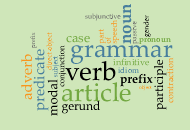|
 How to Teach Count vs. Noncount Nouns How to Teach Count vs. Noncount Nouns
The differences between count and noncount nouns are easier to distinguish in context. For that reason, the following activity has students find nouns in context, use cues to determine if they are count or noncount, and then create novel sentences.
Materials Required
- Each student should bring a 1-page article of interest to class. Ideally, each student will have read the article before arriving.
- Paper and writing utensils for all students.
Timing: 25 minutes
Step 1
The instructor explains the differences between count nouns and noncount nouns. For example, count nouns:
- take an “–s” when they are pluralized (e.g., elephants, flowers, books, costumes); and
- can be preceded by articles such as “a,” “an,” and “the” (e.g., the elephant in the room). minute
In addition to the characteristics noted above, these two categories of nouns differ in terms of which adjectives can precede them. (5 minutes)
|
Type of Noun |
Adjective That Expresses Quantity |
Example Noun |
| count nouns |
many, some, few |
leader, camera, shoe |
| noncount nouns |
much, little, any |
oxygen, heat, furniture, advice |
Step 2
Students read through their article, circling all the nouns they find. (5 minutes)
Students divide a sheet of paper into two columns: count nouns and noncount nouns. Students look at the nouns they circled in their article and determine if they are count nouns or noncount nouns given their context. Students sort the nouns into the appropriate columns. (5 minutes)
Step 3
Students select three count nouns and three noncount nouns from their list and create novel sentences with them, being sure to follow the aforementioned rules above. (10 minutes)
Optional Extension
You can allow students to choose their own article, which increases student motivation. Or, you could kill two birds with one stone and have students select a reading based on the theme of the current lesson.
To lengthen the activity, you might also cover adjectives such as “enough” and “plenty” that can be used with both count and noncount nouns.
Happy teaching,
Michelle
Dr. Michelle Jackson is the associate director of teaching at New Mexico State University’s Teaching Academy. She designs, develops, and delivers workshops on a variety of teaching and learning topics. Prior to NMSU, she was the manager of the English Language Institute at UT El Paso. She has taught English as a second language at UT El Paso and Harvard University as well as Spanish at UT Austin.
|